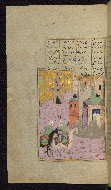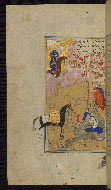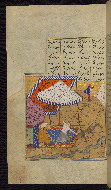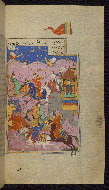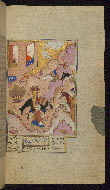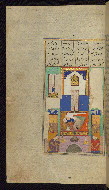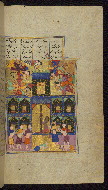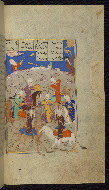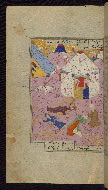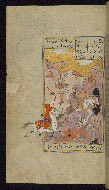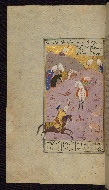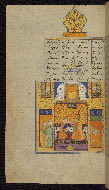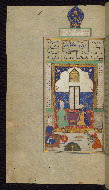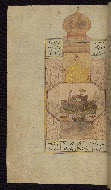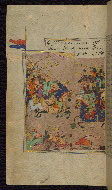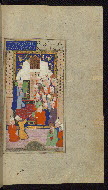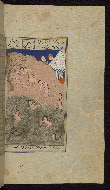Home > Digitized Walters Manuscripts
This document is a tranformation of a TEI P5 XML manuscript description incorporating images. If you have trouble reading special or non-Latin characters on this page, please make sure you have appropriate Unicode fonts installed and an up-to-date web browser.
Walters Ms. W.606, Five poems (quintet)
Browse images (Browse images in a new window) | TEI in XML format
W.606
Five poems (quintet)
Vernacular: خمسه نظامى
Authority name: Niẓāmī Ganjavī, 1140 or 41-1202 or 3
Supplied name: Ilyās ibn Yūsuf Niẓāmī Ganjavī
Name, in vernacular: الياس بن يوسف نظامى گنجوى
Note: Author dates preferred by cataloger: d. 605 AH / 1209 CE
This is an illuminated and illustrated Khamsah (quintet) by Niẓāmī Ganjavī (d. 605 AH / 1209 CE), copied by Muḥammad Mūsá al-Mudhahhib ('the Limner') in Safavid Iran in 924 AH / 1518 CE. The manuscript opens with a double-page illustration (fols. 1b-2a), which is followed by a double-page illumination (fols. 2b-3a). In total, there are six Arabic colophons, one at the end of each of the first four poems and two for the two parts of the final poem (Kitāb-i Sharafnāmah-i Iskandarī and Kitāb-i Iqbālnāmah). The dates of these colophons indicate that the various poems were not executed consecutively. The writing of the text extended over a period of approximately three months, 6 Dhū al-Ḥijjah 923 AH / 1517 CE to 7 Rabīʿ I 924 AH / 1518 CE. The text is written in black nastaʿlīq script with blue subject/section headings. In addition to illuminated titlepieces and headpieces, there are twenty-six illustrations. The binding is not original to the manuscript.
6 Dhū al-Ḥijjah 923 AH / 1517 CE -- 7 Rabīʿ I 924 AH / 1518 CE
Iran
As-written name: Muḥammad Mūsá al-Mudhahhib
Name, in vernacular: محمد موسى المذهب
Known as: Mūsá al-Mudhahhib
Note: The scribe gives his name in the final colophon as Muḥammad al-mashhūr bi-Mūsá al-Mudhahhib, that is Muḥammad, known as Mūsá al-Mudhahhib ('the Limner').
Book
Literary -- Poetry
The primary language in this manuscript is Persian. The secondary language of this manuscript is Arabic.
- Transliteration: qad faragha min taḥrīr hadhā al-kitāb al-mawsūm bi-Iqbāl nānah /1/ Iskandarī min muṣannafāt afḍal al-shuʿarā wa- /2/ afṣaḥ al-bulaghā wa-akmal al-ḥukamā Shaykh Niẓāmī /3/ ʿalá yad al-ʿabd al-faqīr Muḥammad al-mashhūr /4/ bi-Mūsá al-Mudhahhib fī 5 /5/ Muḥarram sanat 924 /6/ m (= tamma) /7/ (fol. 368a)
- Comment: Six colophons in Arabic with the name of the scribe, dated to show that the various poems of the Khamsah were not executed consecutively; dates as follows: 29 Dhū al-Ḥijjah 923 AH (fol. 32a); 7 Rabīʿ I 924 AH (fol. 113a); Ṣafar 924 AH (fol. 169a); 6 Dhū al-Ḥijjah 923 AH (fol. 234a); 19 Muḥarram 924 AH (fol. 320a); 5 Muḥarram 924 AH (fol. 368a)
Paper
Laid paper
Foliation: i+368+i
Catchwords: Written obliquely on versos
Comments:
17.0 cm wide by 29.5 cm high
9.5 cm wide by 18.5 cm high
- Columns: 4
- Ruled lines: 21
- Text written horizontally and obliquely; framing lines in gold and blue
- Title: Khamsah-i Niẓāmī
- Author: Niẓāmī Ganjavī, 1140 or 41-1202 or 3
- Scribe: Muḥammad Mūsá al-Mudhahhib
- Incipit: بسم الله الرحمن الرحيم هست كليد در كنج حكيم...
- Text note: Contains the following books: Makhzan al-asrār (fols. 2b-32a), Khusraw va Shīrīn (fols. 32b-113a), Laylá va Majnūn (fols. 113b-169a), Haft paykar (fols. 169b-234a), Sharafnāmah-i Iskandarī (fols. 234b-320a), and Iqbālnāmah (fols. 320b-368a)
- Hand note: Written in black nastaʿlīq script with blue subject/section headings
- Decoration note: Twenty-six illustrations; double-page illustration (fols. 1b-2a); double-page illumination (fols. 2b-3a); titlepieces (fols. 32b, 113b, 169b, 234b, and 320b); headpieces (fols. 32b, 113b, 169b, 234b, and 320b); framing lines in gold and blue
fol. 1b:
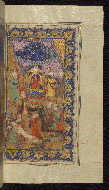
- Title: Double-page illustrated frontispiece
- Form: Illustration; frontispiece
- Label: This is the right side of a double-page illustrated frontispiece depicting a court scene with music and dancing.
fol. 2a:
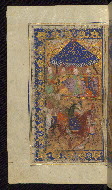
- Title: Double-page illustrated frontispiece
- Form: Illustration; frontispiece
- Label: This is the left side of a double-page illustrated frontispiece depicting a royal pavilion and horses laden with gifts.
fol. 2b:
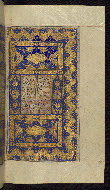
- Title: Double-page illuminated frontispiece
- Form: Frontispiece
- Text: Makhzan al-asrār
- Label: This is the right side of a double-page illuminated frontispiece for the first poem of the Khamsah, Makhzan al-asrār. The upper and lower panels have an inscription in Persian containing the name of the author.
fol. 3a:
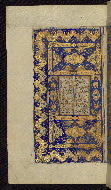
- Title: Double-page illuminated frontispiece
- Form: Frontispiece
- Text: Makhzan al-asrār
- Label: This is the left side of a double-page illuminated frontispiece for the first poem of the Khamsah, Makhzan al-asrār. The upper and lower panels have an inscription in Persian containing the name of the author.
fol. 15a:
fol. 32b:
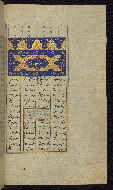
- Title: Incipit with illuminated titlepiece
- Form: Incipit; titlepiece
- Text: Khusraw va Shīrīn
- Label: This illuminated incipit page introduces the second poem of the Khamsah, Khusraw va Shīrīn.
fol. 48a:
fol. 56a:
fol. 61b:
fol. 75b:
fol. 100a:
fol. 106a:
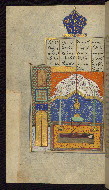
- Title: Death of Shīrīn
- Form: Illustration
- Text: Khusraw va Shīrīn
- Label: Shīrīn, having stabbed herself with a dagger, lies on her husband’s casket to die.
fol. 113b:
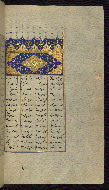
- Title: Incipit with illuminated titlepiece
- Form: Incipit; titlepiece
- Text: Laylá va Majnūn
- Label: This illuminated incipit page introduces the third poem of the Khamsah, Laylá va Majnūn.
fol. 126b:
fol. 133b:
fol. 161a:
fol. 169b:
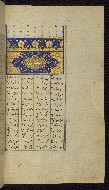
- Title: Incipit with illuminated titlepiece
- Form: Incipit; titlepiece
- Text: Haft paykar
- Label: This illuminated incipit page introduces the fourth poem of the Khamsah, Haft paykar.
fol. 181a:
fol. 188a:
fol. 201a:
fol. 211a:
fol. 217a:
fol. 227b:
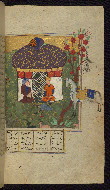
- Title: Bahrām Gūr questions a shepherd who hung his dog on a tree
- Form: Illustration
- Text: Haft paykar
fol. 234b:
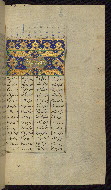
- Title: Incipit with illuminated titlepiece
- Form: Incipit; titlepiece
- Text: Sharafnāmah-i Iskandarī
- Label: This illuminated incipit introduces the Sharafnāmah-i Iskandarī, the first part of the fifth poem of the Khamsah, Iskandarnāmah.
fol. 252a:
fol. 265b:
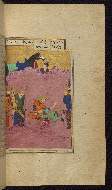
- Title: Alexander the Great laments the death of Darius
- Form: Illustration
- Text: Sharafnāmah-i Iskandarī
fol. 278b:
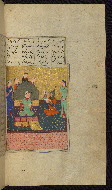
- Title: Alexander the Great admires his portrait made by Nushābah
- Form: Illustration
- Text: Sharafnāmah-i Iskandarī
fol. 297a:
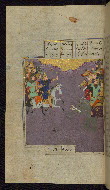
- Title: Alexander the Great fights the army of the king of China
- Form: Illustration
- Text: Sharafnāmah-i Iskandarī
fol. 309a:
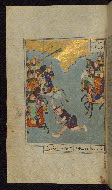
- Title: Alexander the Great lassos a Russian warrior
- Form: Illustration
- Text: Sharafnāmah-i Iskandarī
fol. 320b:
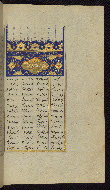
- Title: Incipit with illuminated titlepiece
- Form: Incipit; titlepiece
- Text: Iqbālnāmah
- Label: This illuminated incipit page introduces the Iqbālnāmah, the second part of the fifth poem of the Khamsah, Iskandarnāmah.
fol. 333b:
fol. 350a:
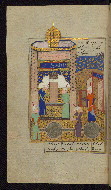
- Title: The paradise of Shaddād Palace discovered by Alexander the Great
- Form: Illustration
- Text: Iqbālnāmah
fol. 354b:
The binding is not original.
Gold-brushed, panel-stamped brown leather (with flap); partially legible verse inscriptions in the upper and lower frames; doublures of red leather with central medallions, pendants, and cornerpieces, also brushed with gold
Walters Art Museum, 1931, by Henry Walters bequest
Storey, C. A. Persian Literature: A Bio-Bibliographical Survey, Vol. 2. (London: Luzac, 1927- ), 438-495.
Principal cataloger: Gacek, Adam
Catalogers: Landau, Amy; Smith, Sita
Copy editor: Bockrath, Diane
Conservators: Jewell, Stephanie; Quandt, Abigail
Contributors: Barrera, Christina; Emery, Doug; Herbert, Lynley; Noel, William; Simpson, Shreve; Tabritha, Ariel; Toth, Michael B.; Valle, Chiara
The Walters Art Museum
Licensed for use under Creative Commons Attribution-NonCommercial-ShareAlike 3.0 Unported Access Rights, http://creativecommons.org/licenses/by-nc-sa/3.0/legalcode. It is requested that copies of any published articles based on the information in this data set be sent to the curator of manuscripts, The Walters Art Museum, 600 North Charles Street, Baltimore MD 21201.
